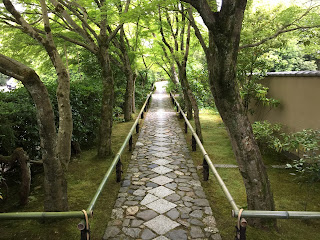2015年の5月に、京都の狩野派展、PARASOPHIA: 京都国際現代芸術祭、KYOTOGRAPHIE 京都国際写真祭 2015、光悦寺などを訪れたときの記録。 In May 2015, I visited to Kano school of Kyoto exhibition, PARASOPHIA: Kyoto International Contemporary Arts Festival, KYOTOGRAPHIE Kyoto International Photography Festival 2015 and Koetsuji so on.
2016年2月11日木曜日
琳派 - 光悦の死 ある時代の終焉 Rinpa - Koetsu's death and the end of a age
本阿弥光悦は、家康からもらいうけたこの鷹峰の地に、楽園ともいえる芸術村を作り、数々の名品を後世に残した。
この鷹峰の地は、豊臣秀吉が、京都の周囲に作った御土居の外側にある。つまり、当時の人々の意識では、京都の外にある地域ということになる。
今も、世界的な観光都市である京都の喧騒とは、無縁の世界が、幸いにもここにはある。
光悦の墓は、この光悦寺の一角にある。
同じ光悦寺の中の少し離れた場所には、光悦の父や母、子や孫などの本阿弥家一族の墓もあった。
光悦が生まれたのは、永禄元年、1558年で、まだ戦国時代の真っ只中だった。
大航海時代の影響は日本にも及び、西日本を中心に、南蛮文化が流行する。
光悦のような、自由な芸術が生まれた背景には、そうした激動する時代の雰囲気があった。
光悦が亡くなったのは、寛永14年、1637年。光悦にこの鷹峰の地を与えた家康はすでに亡く、第3代将軍である家光の時代になっていた。
この寛永14年には、九州で島原の乱が起こっており、江戸幕府はキリシタンなどの外国の影響を徹底的に排除するために、鎖国への道を進んで行くことになる。
光悦の死は、まるで一つの時代の終焉を象徴するような出来事だった。
Honami Koetsu is, in the land of this Takagamine undergoing got from Ieyasu, make art village that can be called paradise, leaving to posterity a number of masterpieces.
The land of this Takagamine is, Hideyoshi Toyotomi, is outside of your Doi made around Kyoto. In other words, in the consciousness of the time of the people, it comes to the region that is outside of Kyoto.
Even now, the Kyoto hustle and bustle is a worldwide tourist city, unrelated to the world, there is fortunately here.
Tomb of Koetsu is on the corner of this Koetsuji.
Same in a little away in the Koetsuji, father and mother of Koetsu, was also the tomb of Honami family home, such as child and grandchildren.
Koetsu's was born, Eiroku first year, in 1558, it was still in the midst of the Warring States period.
The influence of the Age of Discovery spans also in Japan, especially in the West, barbarian culture is prevalent.
Koetsu such as, in the free art was born background, there was atmosphere of the times that such upheaval.
Koetsu's passed away, in 1637. Ieyasu gave the land of Takagamine already died, it had become a house light of the era is the third shogun.
The 1637, and going on the Shimabara Rebellion in Kyushu, the Edo shogunate in order to eliminate thoroughly the foreign influence of the Christian, it would be to go down the road to the seclusion.
Death of Koetsu was the event, such as to symbolize the demise of like one of the era.
(Translated by Google Translate)
琳派 - 書人としての光悦 Rinpa - Koetsu as a Calligrapher
光悦寺の中は、木々が押し茂っており、全体を見通すことができない。
迷路のような内部を、立て札などを頼りに、ぐるぐると、巡ることになる。
これも、光悦のデザインなのだろう。現代の空間デザインや、都市デザインに通じるところがある。
光悦は、寛政の三筆に数えられる書人でもある。
俵屋宗達の下絵の上に和歌を書いた、数々の和歌の書が、とりわけ有名だ。
光悦は、熱心な日蓮教徒でもあったが、その光悦が書いた、日蓮の立正安国論をある展覧会で目にしたことがある。
和歌などの華麗な書に比べると、いわゆる遊びの部分は、影を潜めている。
しかし、文字の大きさを変えたり、同じ字の字体をわざと変えたりと、光悦らしさは十分に現れている名品だ。
Koetsuji Among, the trees have overgrown press, it is impossible to see through the whole.
The internal maze-like, to rely on, such as Tatefuda, round and round, will be over.
This is also, probably design of Koetsu. And contemporary of space design, there is a place that leads to the city design.
Koetsu is also in writing who is counted in there best calligraphers in Kansei age.
He wrote a poem on the Sotatsu Tawaraya sketch, The Book of numerous poetry, but especially famous.
Koetsu, which was also an avid Nichiren Muslims, the Koetsu wrote, there is a thing that you see in the exhibition which is a stand Masayasu public opinion of Nichiren.
Compared to the brilliant writing, such as poetry, part of the so-called play is hushed shadow.
However, changing the size of the character, and intentionally or changing the font of the same character, but masterpieces Koetsu likeness is that enough to appear.
(Translated by Google Translate)
琳派 - デザイナーとしての本阿弥光悦 Rinpa - Koetsu as a designer
光悦寺の大虚庵は、光悦が建てた茶室だが、その茶室自体よりも、それを囲む生垣が、光悦垣つとに知られている。
竹を編んだ独特の構成は、光悦のデザインセンスの高さを後世に伝えている。
光悦は、家業である刀の修理や目利きなどを行いながら、いろいろな工芸品を作ったりもしている。
国宝に指定されている、舟橋蒔絵硯箱は、不必要に盛り上がった上蓋が印象的な、光悦を代表するデザインだ。
また、光悦は、数多くの茶碗を作っている。
光悦の作った、不二山という茶碗は、国宝にもなっている。
光悦の茶碗は、すべて轆轤を使わずに、手を作って作られたもので、同じ京都の楽茶碗に影響を受けているようだ。
飲み口が特徴で、飲む人が飲みやすいというよりは、むしろ飲みにくく、飲むことを拒絶しているような印象がある。
硯箱にしても、茶碗にしても、道具としての本来の役割ではなく、造形的な美しさや、遊びを優先してデザインしているのが、光悦のデザインの特徴と言えそうだ。
それは、光悦のみならず、琳派全体に言えることであるかもしれない。
Taikyoan of Koetsuji is, but tearoom Koetsu was built, than the tea house itself, the hedge surrounding it, known early in the fence Koetsu.
Unique configuration braided bamboo is transmitted to posterity the design sense of the height of the Koetsu.
Koetsu is, while performing such as repair and connoisseur of the sword is a family business, it is also or create a variety of crafts.
Has been designated as a national treasure, Funabashi Makie writing box, the lid was raised to unnecessary is impressive, it is design to represent the Koetsu.
In addition, Koetsu is making a number of tea cup.
Koetsu made of, teacup that Fuji has also become a national treasure.
Cup of Koetsu, all without using a potter's wheel, which has been made to make a hand, seems to be influenced by the ease bowl of the same in Kyoto.
Drinking is a feature, rather than easy to drink a person to drink, there is impression that refused to rather difficult to drink, drink.
Even in the writing box, even in the bowl, rather than the original role as a tool, and the figurative beauty, are you design in favor of the play, likely say that features of the design of Koetsu.
It is not Koetsu only, it may be that said throughout Rinpa.
(Translated by Google Translate)
琳派 - 刀の目利きとしての本阿弥光悦 Rinpa - Honami Koetsu as a connoisseur of the sword
京都、鷹峰の法悦寺の門構え、そしてそのアプローチは、実に美しい。
本阿弥光悦の美意識を、そのままこの世の形として、表現したようだ。
光悦寺を訪れる人は、心穏やかに、この小道を歩き、その中への進んでいく。
本阿弥光悦は、代々、足利将軍家に使え、刀の修理や目利きを行っていた家柄に生まれた。
足利将軍家には、能楽の世阿弥などを始め、なんとか阿弥、という同朋集という人々がいた。
阿弥という名前は、元は時衆の信者だったが、本阿弥光悦自身は、日蓮宗の熱心な教徒だった。
光悦が生きた時代は、足利時代の終わりである戦国時代から江戸時代の時代の変わり目だった。
江戸時代の文化は、まだ生まれておらず、文化の中心はまだ京都で、足利将軍家に使えていた職人や文化人たちが、当時の文化の担い手だった。
光悦や宗達、その後の尾形光琳が作り出した琳派という芸術は、やがて、江戸時代の文化を象徴する存在になっていく。
Kyoto, Mongamae of ecstasy temple of Takagamine and its approach, is really beautiful.
The aesthetics of Honami Koetsu, as it is in the form of this world, seems to have representation.
Visitors to Koetsuji is, mind gently, to walk this path, proceed into that.
Honami Koetsu is, from generation to generation, can be used to Ashikaga shogunate, was born to the family that was going to repair and connoisseur of the sword.
The Ashikaga shogunate, started such as Zeami of Noh, was somehow Honami, people buy that companions collection called.
Named Ami, but the original was a believer of Tokishu, Honami Koetsu itself, was an avid Muslims of Nichiren Buddhism.
Koetsu lived era, it was the turn of the Edo era of the era from the Warring States period is the end of the Ashikaga era.
Culture of the Edo period, not yet born, the center of the culture is still in Kyoto, artisans and cultural people who had used the Ashikaga shogunate is, was a leading figure at the time of culture.
Koetsu and Sotatsu, art is that subsequent Korin Ogata has created Rimpa, eventually, will become a presence to symbolize the culture of the Edo era.
(Translated by Google Translate)
登録:
コメント (Atom)








